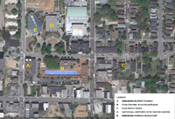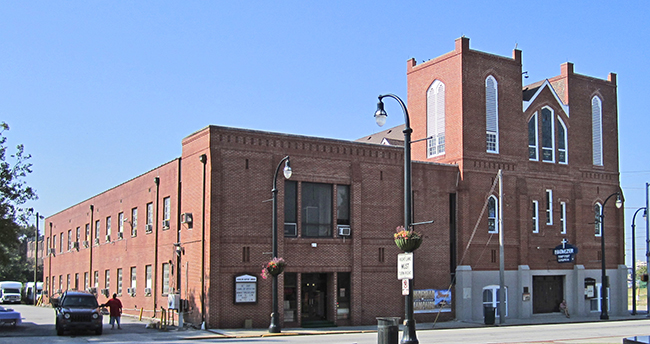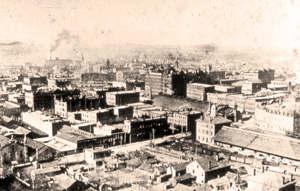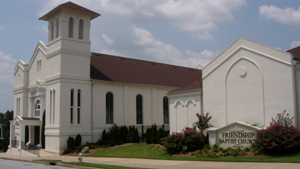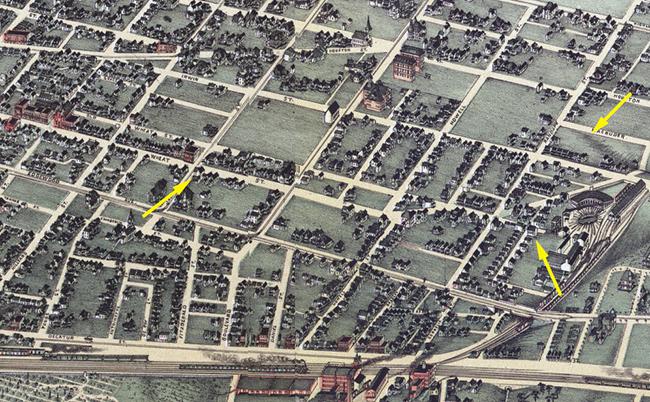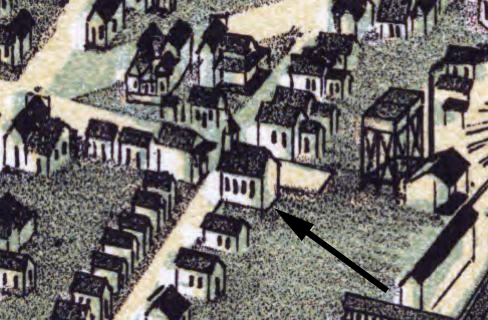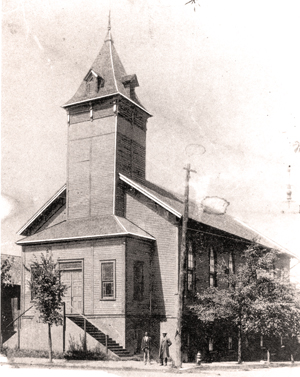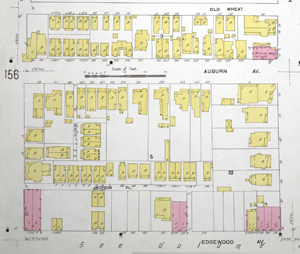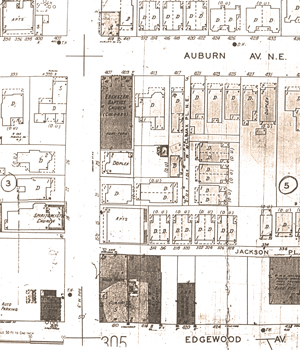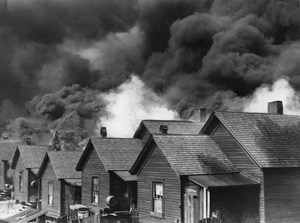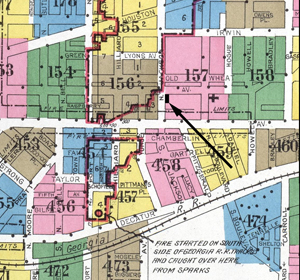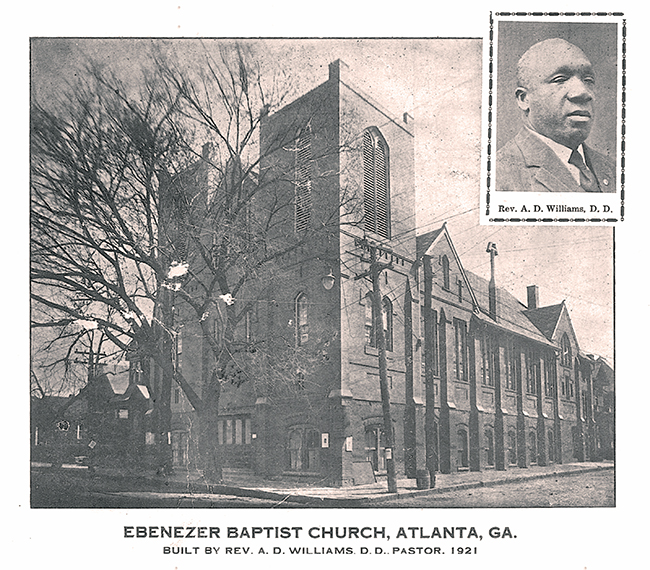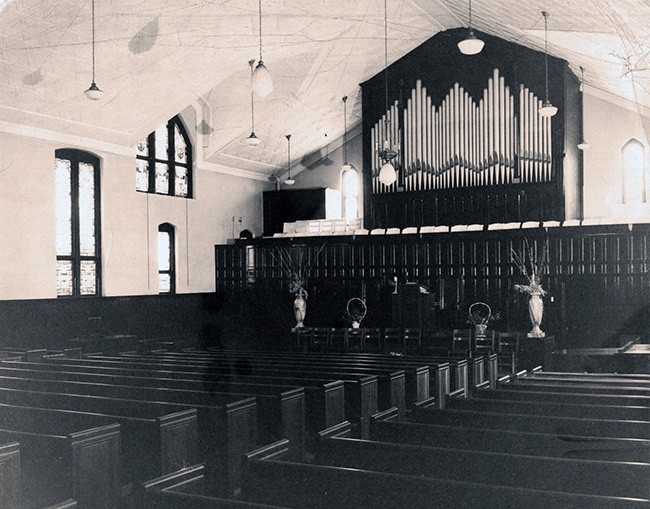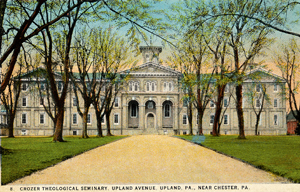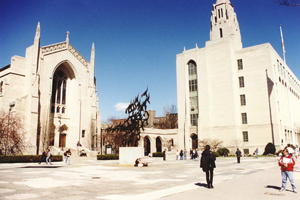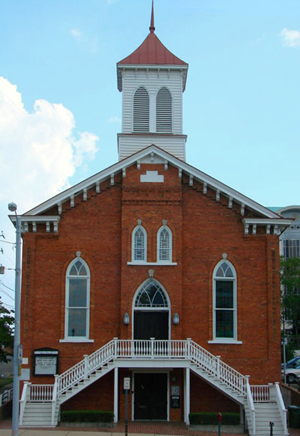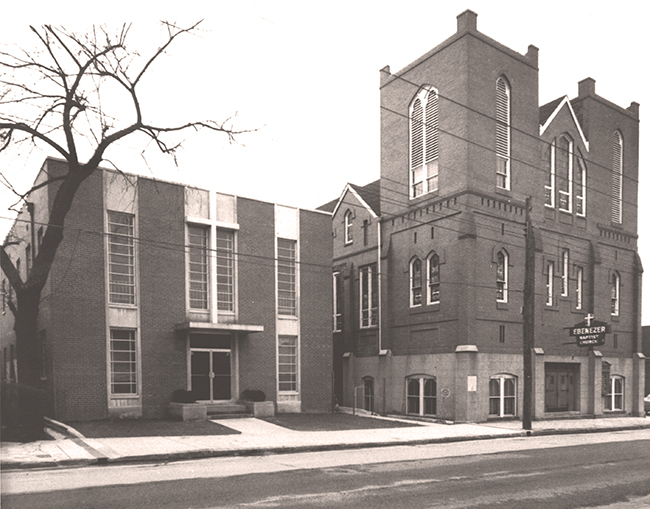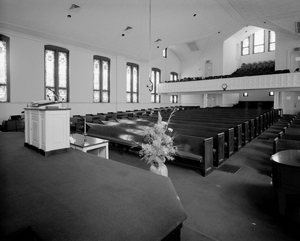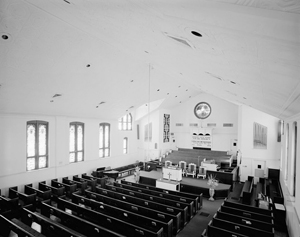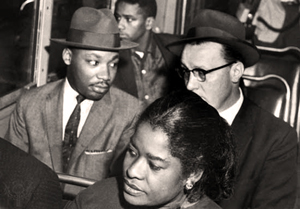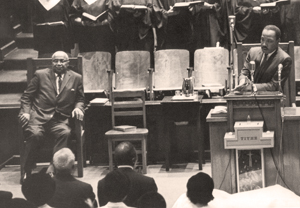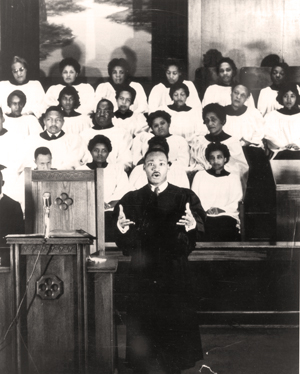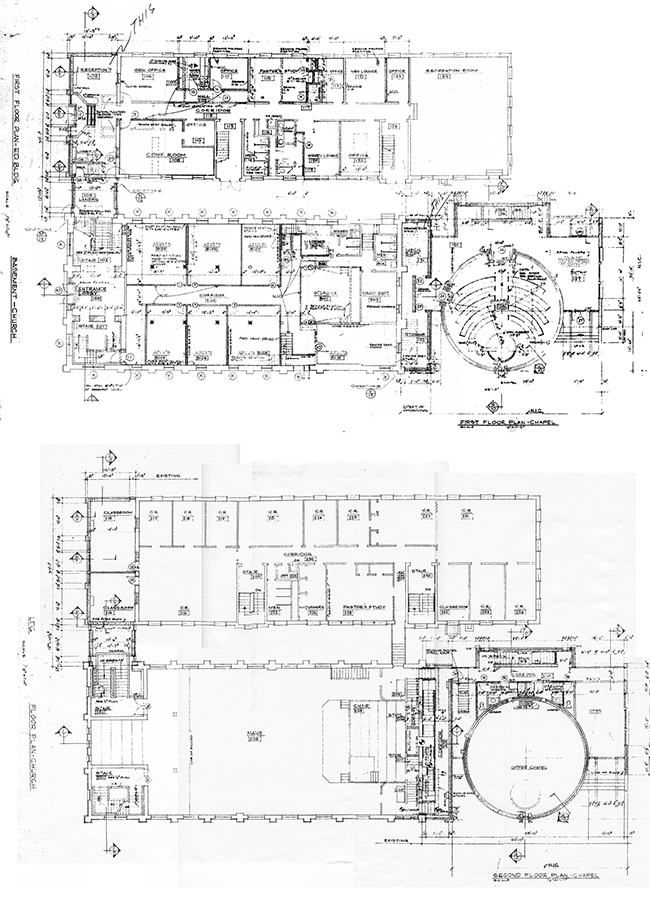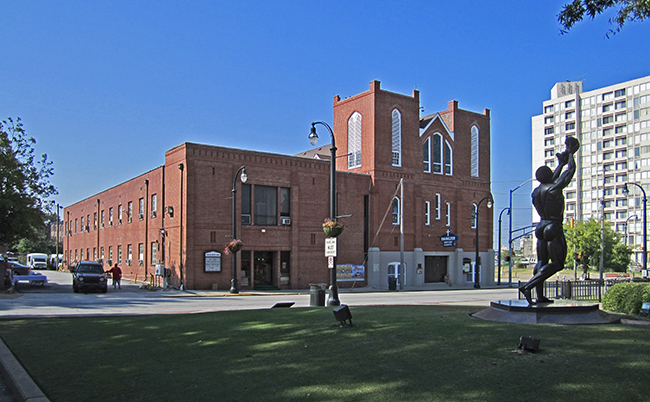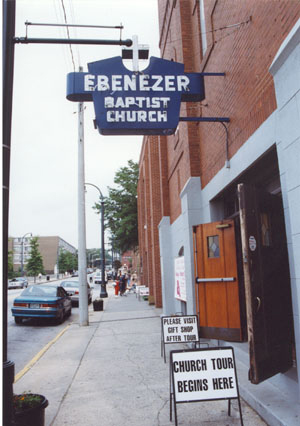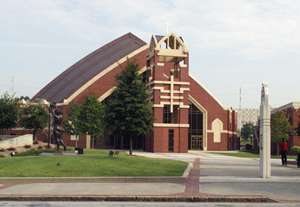Ebenezer Baptist Church represents one of the major influences in the life of Dr. Martin Luther King Jr. His maternal grandfather Rev. Adam Daniel Williams and his father, Rev. Martin Luther King Sr., were pastors there and the family lived just up Auburn Avenue from the church until 1941 when they moved to a larger house on Boulevard, still only a few blocks from Ebenezer. The young Dr. King attended Sunday School at Ebenezer and was baptized in the old baptismal in the basement. As he came of age in the late 1940s, he naturally used Ebenezer as a platform from which to launch his own preaching career.
Because of his leadership in the Civil Rights Movement, Ebenezer was often the site of meetings and rallies, including the organizational meetings that led to the founding of the Southern Christian Leadership Conference in 1957. Dr. King traveled widely and spent most of the early 1950s doing his post-graduate work in Pennsylvania and Massachusetts before moving to Montgomery, Alabama, in 1954. But Atlanta, where he was born and raised, was always his home and at the center of his work, and in 1960, he joined his father as co-pastor at Ebenezer, a position he held until his death. His funeral was held from the church in April 1968.
This history of Ebenezer Baptist Church is a revised version of a developmental history that was produced for the National Park Service in 1999. That original study included historical background and context, a chronology of the building's construction and later alterations and additions, and a description of the building as it existed at that time. In 2000, additional research provided documentation for events in the immediate aftermath of Dr. King's assassination, including his widow's incorporation of the Martin Luther King Memorial Center, now known simply as the King Center, and the spontaneous development of the church as a tourist attraction during that same time. These events had a direct impact on the church and the surrounding neighborhood. Within a year of Dr. King's death, development of the Memorial Center on Auburn Avenue had begun as had planning for major alterations to Ebenezer in 1970-1971, in large part to accomodate increased tourism.
Leased and operated by the National Park Service since 1996, the church has recently undergone a multi-million dollar rehabilitation that included restoration of the sanctuary to its appearance in 1968.
|
Figure 1. Ebenezer Baptist Church, after restoration of the bell towers. (Author's photograph) |
Atlanta
Within twenty years of its almost total destruction in 1864, Atlanta was the third largest metropolis in the old Confederacy, the "Gate City" of the "New South." From a population under 10,000 in 1860, the city’s population doubled by 1870, and nearly doubled again by 1880. Much of that increase came from the migration of thousands of African Americans into the city, drawn by what they hoped would be better prospects for life away from the drudgery of labor in the cotton fields. Almost completely segregated from white Atlanta by the 1890s, black Atlanta thrived and, in spite of the rise of Jim Crow, created its own social, religious, educational, and commercial institutions. Especially important were the African-American institutions of higher learning, including Atlanta University (1865), Clark College (1869), Morris Brown College (1881), and several others.
Along with the African American schools that were organized in Atlanta in the decade or two after the Civil War, several African-American churches, of which there had been none in city before the war, were organized. Big Bethel African American Episcopal (A.M.E.) is the oldest of the city's black churches, having its roots as a Methodist congregation as early as 1847. Formally organized as an A.M.E. church in 1865, it is considered the mother church for the denomination in north Georgia.
In 1867, missionaries from the American Missionary Society, who had established a freedman's school on Piedmont Avenue, joined with freedmen to form Atlanta's First Congregational Church. Integrated for the first few years of its existence, it remained one of the most-influential African-American congregations in the city in the twentieth century.
Throughout the city, the vast majority of churches, black or white, were Baptist or Methodist, and the Baptists with their "priesthood of the believer" appealed to African Americans in a way that many other denominations could not. Independent African-American congregations were few in the South before the Civil War, but they did exist, most notably in the First African Baptist Church, organized in Savannah in 1788 and claimed as the oldest African-American congregation in the country.
With emancipation, African-American Baptist churches proliferated. With no more formal authority than their own interpretation of the Bible, a group of people could easily establish a Baptist church, with many of these springing up in close proximity to older white congregations. It was no accident that so many of the earliest African-American churches in Atlanta were Baptist.
Friendship Baptist originated in a congregation that began meeting in 1862 but was not formally organized as a Baptist church until 1866. Located just southwest of downtown, it was the first black Baptist church in the city and grew along with nearby Atlanta University. It established a number of mission churches in the 1870s and 1880s, making it the "mother church" for the city's African-American Baptist congregations.
Wheat Street Baptist Church was one of those missions when it was organized in 1871. It quickly rivaled Big Bethel, both in size and in influence, and itself established its own mission churches, one of which was Ebenezer. In the twentieth century, especially under the leadership of its long-time pastor Rev. William Holmes Borders, Wheat Street Baptist Church gained a reputation as one of the city's most activist congregations.
|
Figure 4. Detail from Saunders and Kline's bird's-eye view of Atlanta in 1892, annotated with arrows to locate the original Ebenezer Baptist Church building on Airline Avenue, center right, near the Air Line Railroad roundhouse; the site of the congregation's building on McGruder Street, upper iright; and the site of the present Ebenezer Baptist Church, left of center. Morris Brown College is depicted in the red-brick builidings, upper center. (Atlanta History Center) |
A New Congregation
According to church tradition, Rev. John A. Parker, a member of Wheat Street Baptist, organized Ebenezer Baptist Church “in the latter part of November 1886.” [1] At that time, Wheat Street church was located at the corner of what are now Old Wheat Street and Fort Street on the western edge of the Old Fourth Ward; Ebenezer was organized to serve the working-class neighborhood that had sprung up in the late 1870s and 1880s along the ward's eastern edge.
Construction of the Atlanta and Richmond Air Line Railroad, which forms the eastern boundary of the Old Fourth Ward and is now part of Atlanta's "Belt Line," began in 1869 at the Georgia Railroad, just west of Boulevard, but the company went bankrupt and was re-organized as the Atlanta and Charlotte Air Line Railroad in 1877. Shortly after that, the company constructed a railroad round house and machine shops near the line's intersection with the Georgia Railroad, offering employment to some African Americans and giving additional impetus to the growth of the African-American community that was already developing in association with Morris Brown College, a few blocks to the northwest.
|
Figure 5. Detail from 1892 bird's-eye view of Atlanta, annotated with an arrow to locate the original Ebenezer Baptist Church at the southeast corner of Air Line Street and Old Wheat Street. |
“In a short time” after the church’s organization, according to church history, the congregation boasted fifty members and was meeting in a “box-like structure” on Airline Street, a narrow street that no longer exists but which paralleled today's Belt Line corridor between Auburn and DeKalb Avenues. Saunders’ 1892 bird’s-eye map of Atlanta indicates a steepled church on the east side of Airline Street (originally Air-Line, after the Atlanta and Charlotte Air-Line Railroad), opposite its intersection with Old Wheat Street east of Randolph Street. Although Ebenezer is not listed in the city directories before 1900, there is no other church known to have existed on Airline during this period either, and it seems likely that the church shown on the map was the original Ebenezer Baptist Church. [2]
There is no record that the congregation ever held title to the Airline Street church, although it may have been held by one of the members. In any case, the site was heavily mortgaged, according to a later account, and the congregation may even have lost possession of the building by the time Parker died in early 1894. [3]
Reverend A. D. Williams
On 4 March 1894, Rev. Adam Daniel Williams (1861-1931) was called to pastor the struggling congregation, which by then had dwindled to around eighteen members and was meeting “in a small shack” on Airline Street. Williams, who had only moved to Atlanta from Greene County, Georgia, a few months before, proved to be a dynamic leader and, within a year, membership had grown to sixty-five. Over the next few years, he saw Ebenezer through an era of rapid growth that, by 1904, made it the second largest African-American congregation on the east side of Atlanta. [4]
Perhaps as early as 1897, the congregation was strong enough to buy a lot on McGruder Street where they may have built a church in 1897 or 1898. The building could not have been large and, with a membership of 120, the congregation bought “a beautiful, spacious structure, 40 x 80," at 176 Gilmer Street in December 1900. The wood-framed building, which had been built in the 1870s for the white congregation of the Fifth Baptist Church, was sold for $2500, “together with . . . all furniture in said church except organs, pulpit set, books, communion set and desk.” [5]
By the early 1900s, Williams was one of the city's more successful African-American pastors, adding 91 members to the church rolls and collecting $2,376.58 in contributions in 1903 alone. With a membership over 400, Williams’ “church society,” a contemporary account noted, was “one of the strongest in the city, having upward of $500 in bank,[with] all departments of the church . . . in a flourishing condition.” Williams’ success at fund-raising would be legendary over the years, even though, as that same account noted, he always worked “under the shadow of Wheat Street Baptist and Bethel A. M. E. Churches, two of the most influential churches in our city.” [6]
|
Figure 6. Ebenezer's building on Gilmer Street. (Ebenezer Baptist Church) |
|
Figure 7. Detail from 1911 Sanborn Fire Insurance Company map showing the block on Auburn Avenue between Jackson Street and Boulevard. The future site of Ebenezer at the southeast corner of Auburn and Jackson was still occupied by a single-family house. |
|
Figure 8. Detail from 1924 Sanborn Fire Insurance Company map showing Ebenezer shortly after its completion. |
In the early 1900s, Jim Crow and segregation were being ever more-rigidly enforced, often with virulent attacks on African Americans. Goaded especially by the racism of The Atlanta Georgian, one of the city’s three daily papers, and by the vicious race-baiting of the 1906 gubernatorial campaign, white Atlanta erupted into a three-day race riot in September 1906 that left at least a dozen black citizens dead and scores injured. As a result, in the years leading up to World War I, the city became increasingly segregated, and the old racially-integrated residential patterns soon disappeared, transforming old neighborhoods like the Old Fourth Ward into predominantly black communities within the space of a few years. In addition, the city’s black entrepreneurs, who were severely restricted in their options for business downtown, transformed Auburn Avenue into a “black Peachtree.” The opening of the Odd Fellows Building in 1912 and its Auditorium in 1914 symbolized the beginning of the heyday of “Sweet Auburn.”
A New Building
Ebenezer continued to grow as a congregation during that period and, perhaps as part of the increasing segregation of Atlanta after 1906, they began searching for a new location away from downtown. Rev. Williams was active in real estate and the congregation appears to have considered several options for a new home. In September 1912, the congregation acquired a lot on the west side of Boulevard, just south of Auburn, apparently with the intent of constructing a church there. A better location apparently became available and, on 10 January 1913, Williams received a bond for title to a lot at the southeast corner of Auburn Avenue and Jackson Street, which was to become Ebenezer’s permanent home. [7]
The seller of the Auburn Avenue lot was A. J. Dalbridge, an ex-slave and shoemaker who was one of the larger property owners in Atlanta’s African-American community.The purchase price for the property was $5,750, with $1,000 down and four annual payments beginning 10 April 1913. [8]
In February 1913, Ebenezer sold the lot on Boulevard to the Odd Fellows and, in March, Rev. Williams conveyed the property on Auburn Avenue at Jackson Street to the church’s trustees. Preparations for construction probably began about that time. A two-story, wood-framed house had been built on the lot in the 1890s when Auburn Avenue was still a primarily white residential thoroughfare, and the first order of business would have been its removal. It is not known if it was moved or simply torn down. [9]
In July 1913, Ebenezer announced plans for a “rally for the benefit of the new Twenty-five Thousand Dollar Church, which will be erected on their lot, corner Auburn and Jackson Streets. The combined seating capacity of the main auditorium and the gallery will aggregate twelve hundred and fifty. . . . Now with 750 substantial members, Ebenezer is going to erect a modern Church edifice that will be in keeping with the great city of Atlanta.” The newspaper article announcing the rally went on to note that “few churches in the city have made strides more rapidly, nor have contributed more to the moral and intellectual growth of the city. Dr. Williams is an earnest, conscientious and well-informed minister whose influence in the city is acknowledged and appreciated.” [10]
In spite of the confidence of that report, as late as the fall of 1913, construction had not yet begun on the new site, and information collected at that time for the 1914 Atlanta City Directory still listed Ebenezer at the old Gilmer Street address. Nevertheless, on 10 November 1913, the trustees sold the old church building for $5000 and, by January 1914, were meeting in a one-story, concrete-block store at the northwest corner of Howell Street and Edgewood Avenue. [11]
Finally, at 2:00 PM, Monday, 17 March 1914, Ebenezer held public “ground breaking exercises” for the new building. There is no date of installation on the corner stone, but it may have been laid around this time as well. When it was opened twenty-five years later, the stone was found to contain deeds, a membership list, and other documents related to the church’s early history as well as “a bottle of dried-up wine.” Noting that the church was founded in November 1886, the original inscription on the cornerstone included the names of the church’s officers—J. W. Johnson, Chairman, H. G. Edwards, Vice-Chairman, P. O. Watson, Secretary, and P. Y. Veasey, Treasurer—and of its deacons—R. B. Hunter, G. W. Scott, George Dalton, Dock Hill, J. F. Harris, J. W. Walker, W. M. Moore, Rastus Kennedy, Samuel Martin, Jethro English [Sr.], and L. M. Brantley. The inscription also instructed that “the Receptacle in this stone to be opened and contents read March 1939.” The stone was laid by Smooth Ashlar York Rite Lodge, “F & A, A. Y. M. N. C.” [12]
In spite of Rev. Williams’ repute as a successful fund-raiser, the congregation had considerable difficulty in supporting construction and, by that summer, was still “struggling to get into the basement” of their new building. In late June 1914, the Atlanta Independent reported that the congregation was “appealing to the people for financial aid” in completing their building. The congregation was making, the report continued, “strenuous efforts to raise $2,000 by the second Sunday in July. Dr. Williams will for that purpose give a grand pit cooked barbecue” that was guaranteed to “eclipse any barbecue ever given here.”[13]
Fund-raising must have been successful and, on 29 August 1914, the newspaper reported
Ebenezer Baptist membership, their friends and admirers will worship in their own edifice tomorrow, Sunday, August 30th, inst. The basement has been fully and handsomely completed. It is beautifully equipped with pews, electric [sic] and such church fixtures as progressive Atlanta approves. The seating capacity [of the basement] covers 3,200 square feet and will easily seat six hundred.. . . When they shall have completed their church in its entirety, they will have one of the most modern church buildings in the State. [14]
No plans for completion of the church were announced as the congregation occupied the newly-finished basement in 1914, probably because they still needed another $15,000 to complete the building. In this, Ebenezer was not unusual in taking years to complete its building. Limited funding forced many congregations, black and white, to build their churches in phases over a period of years. Even Wheat Street Baptist, which announced plans for their present building in 1922, was unable to complete it until 1939.
Ebenezer also faced the increasing turmoil and disruption in the black community as the “Great Migration” got underway during World War I. Brought on by the collapse of the farm economy under the onslaught of the boll weevil and by the generally wretched oppression and submarginal wages that they were forced to endure, this migration drained away a half million Southern blacks seeking better job opportunities in the North and set back the nascent development of many African-American institutions, churches, and communities. As the war grew and cotton prices rose, the labor shortage became so acute that threats and intimidation were used by white landowners and businessmen in a futile attempt to stem the tide; but it continued, nonetheless, with 50,000 leaving Georgia in 1916 alone. Even Reverend Williams was tempted to leave the South and considered accepting a pastorate in Columbus, Ohio, in 1919. [15]
Ebenezer was only one of many churches that watched its congregation melt away in the late 1910s and early 1920s. Between 1918 and 1924, Ebenezer’s membership declined from 900 to 280, a decline that some have interpreted as a sign of competition from younger preachers but which may have been more directly related to general out-migration. [16] Undoubtedly, shrinking membership severely curtailed the congregation’s financial resources and was the main factor in delaying completion of the building.
|
Figure 9. Houses burning in northeast Atlanta, 21 May 1917. (Atlanta Housing Authority) |
|
Figure 10. Detail from Sanborn Fire Insurance Company map depicting the extent of the areas burned in the May 1917 fire, annnotated with an arrow to locate Ebenezer Baptist Church. |
In addition to the general out-migration during the period, Ebenezer’s congregation must have suffered from Atlanta’s “Great Fire” in May 1917. Beginning in a shop near Fort and Decatur Streets, three blocks southwest of the church, and whipped by high winds, the fire burned virtually unchecked northeastward along Hilliard, Jackson, and Boulevard before finally burning itself out against a line of dynamited houses on the north side of Ponce de Leon Avenue, nearly a mile and a half north of Ebenezer. Nineteen hundred families, representing five percent of the city’s population, were left homeless, with the overcrowded black neighborhoods along Auburn Avenue and Old Wheat Street being especially hard hit. Ebenezer itself appears not to have been damaged in the fire, although the blocks immediately west and northwest of the church, including Wheat Street Baptist Church, were destroyed.
In the fire’s aftermath, the poor, black residents on the east side often could not afford to rebuild and, in any case, many took the opportunity to relocate to the new African-American residential district that was developing on the west side of Atlanta. With the demands that rebuilding from the fire must have put on the church’s membership and with the inevitable loss of members that must also have occurred, it is not surprising that completion of the church was delayed even longer. [17]
The congregation may have made some plans to continue construction on the church while the community rebuilt itself in 1918. That does not seem likely, however, since it was not until June 1919 that A. J. Dalbridge finally conveyed title of the property to Ebenezer, indicating that the original mortgage had been paid off, two years behind schedule. Not until 4 June 1921 did Rev. Williams apply to the city for a permit to “build one stry & basement brick church” at an estimated cost of $30,000. No architect was listed on the permit and “day” (meaning day labor) was the only description of the builder. [18]
An additional cornerstone ceremony may have been held a week or so later, since the date of “June 12, 1921" has been added at the bottom of the original stone. Presumably, the congregation continued to use the basement for services while construction continued on the sanctuary.
While several articles concerning Ebenezer’s original construction appeared in the Atlanta Independent in 1913 and 1914, there is no mention of the building’s completion in the 1921 and 1922 papers. In November, the church secured a loan from the Standard Life Insurance for $12,288 to help finance construction, with payments due each November 1922-1926. [19] Although the building permit was completed early in 1922 and the building probably occupied around that time, there is every indication that the building was only barely finished, lacking at least the stucco that was intended to finish the exterior of the basement.
|
Figure 11. Ebenezer Baptist Church shortly after it was completed in 1922, from an un-dated church brochure, which was printed with the inset image of Revevernd Williams. (Ebenezer Baptist Church) |
Even with the building finished and occupied (at a total cost of $40,000, according to one source, the diminished congregation struggled to keep it open, leading Rev. Williams to issue a public appeal for donations from the larger community to retire the $3,500 that the congregation still owed on the building in 1924. The appeal, which was issued to Rev. Williams’ “good friends, white and black without regard to denomination,” noted that Ebenezer’s membership consisted “most largely of working people who are employed by their white neighbors and their ability to contribute is limited by the salary they receive.” How successful Williams was in this appeal has not been recorded. [20]
It appears that Ebenezer’s membership continued to decline after 1924 until finally stabilizing around 200 on the eve of the Great Depression. [21] Among the few new members was Rev. Martin Luther King Sr., who married the Williams’ daughter, Alberta, at Ebenezer on 25 November 1926. Taking up residence with the Williams at 501 Auburn Avenue, King continued to preach at churches in East Point, College Park, and elsewhere around Atlanta, but the center of his life remained Auburn Avenue. Three children were born to Reverend and Mrs. King—Christine in 1927, Martin Luther “M. L.” King Jr. in 1929, and Adam Daniel “A. D.” King in 1931, all of whom were born at the Williams’ house at 501 Auburn Avenue.
When Rev. Williams died of a heart attack on 21 March 1931, the congregation was devastated. From a struggling congregation meeting “in a shack” on Airline Street in 1894, he had led Ebenezer in becoming one of the city’s great African-American churches. Now, with the membership sharply reduced by forces entirely out of its control, the prospect of finding a replacement for the beloved Reverend Williams must have seemed daunting.
Rev. Martin Luther King Sr.
Martin Luther King Sr. (1899-1984) was not the congregation’s immediate choice for pastor. Some of the deacons felt that an older, more experienced man would be a more suitable replacement for Reverend Williams. In addition, King himself was serving as pastor at Traveler’s Rest Baptist Church, where his wife wished him to remain. It was only after Mrs. Williams spoke on her son-in-law’s behalf that the trustees finally offered Reveverend King the pastorate in October 1931. [22]
Reverend King found the congregation on the verge of losing their building. Late in 1931, the realty company that held the mortgage on the church, which had an outstanding balance of $1,100, went bankrupt. The new mortgage holder was Atlanta Federal Savings Bank which, without notice to the congregation, abruptly padlocked the doors at Ebenezer. Only by the considerable negotiating skills of Reverend King was the congregation able to refinance their mortgage and reopen the church. [23]
Officially installed as pastor in April 1932, King continued much of Williams’ earlier work as he quickly gained the congregation’s love and respect. He established a building fund and, within a year, was even given a raise, making him one of the best-paid ministers among Atlanta’s African-American churches. The congregation had always been generous within its means, and Reverend King was a master at soliciting the dimes, quarters, and dollars that helped pay off the mortgage early in 1935, eighteen months ahead of schedule. At the same time, Reverend King continued Reverend Williams’ leadership in providing aid to those in need, and much of the money that was raised was “poured back into the community” as the local economy deteriorated in the early 1930s. Besides providing food and clothing to those in need, Ebenezer ran a day-care center, bought and supplied medicines and, as King wrote in his autobiography, “tried to be an anchor as the storm rose.” [24]
Reverend King’s stature within the community grew throughout the 1930s. He was active in the local chapter of the NAACP, which his father-in-law had helped found in 1918, and in the Atlanta Missionary Baptist Association, of which he was elected moderator in October 1935. He was also a leader in many efforts to organize the African-American community and was elected president of the Atlanta Ministers Council, an interdenominational organization of ministers dedicated to fighting “the Negroes’ battles along civic, political, and educational lines.” [25]
As the economy improved in the 1930s, the growing congregation at Ebenezer was able to make some improvements to the building before the outbreak of World War II. Whether or not these changes occurred as part of a single project has not been documented, but they included installation of carpeting, replacement of the pulpit furniture, and changing of the “usual hard Church benches to the present modern pews,” a distinction that is difficult to understand today. [26] In addition, it is believed that the pink marble urns currently in the sanctuary were donated around this time by Mrs. Nannien W. Crawford, long-time member of Ebenezer, general director of Ebenezer’s Baptist Training Union and secretary of the State Sunday School Convention in Georgia.
|
Figure 12. The sanctuary at Ebenezer, showing the original choir loft behind the pulpit and the pipes for the great Wurlitzer organ that was installed in 1940. (Ebenezer Baptist Church) |
While these changes escaped notice in the local papers, the “crack new,” two-manual, Wurlitzer organ that was installed in the fall of 1940 did not. Mrs. King had continued the church choir begun by her mother-in-law, Jennie Celeste Williams, but had also organized a second choir in 1932 and, later, a third as well. In September 1937, she initiated the first in a series of annual musicals at the church, although she was no doubt hampered in their presentation by the old mechanical John Brown organ, which is thought to have been brought to the church from the Gilmer Street church. According to a contemporary newspaper account, the new organ was “said to be the most modern type available. . . . It can be reduced to a tone so soft that the average ear would be strained to hear it, and can be increased to a volume so great it will shake the edifice.” [27]
Installed by Neal Davis of the L. J. Davis and Son Company, the organ was dedicated “before a house packed from floor to gallery” on Friday evening, 1 November 1940. “Bringing back the sainted memory of the late Dr. A. D. Williams,” according to the newspaper, “Rev. King dedicated the organ in memory of Dr. Williams. . . [and] music lovers from throughout the city” heard a “thrilling program” under the direction of Mrs. King and L. B. Byron, the church organists. Leading off the program was Graham Jackson, the nationally-acclaimed musician and perennial favorite of Franklin Delano Roosevelt. Jackson “took the audience by surprise when he rendered a number depicting bombs falling in Europe, breaking it off with a piece in which one could still hear the praise of God.” A variety of other musicians, including Byron and Mrs. King, performed as well, as did the choirs of Ebenezer. [28]
By World War II, Ebenezer was clearly recovering from the turmoil and hard times of the preceding twenty-five years and, as agitation for civil rights increased dramatically after the war, Ebenezer and other African-American churches, as they always had, often hosted rallies and meetings in support of the cause. [29] In November 1945, for example, Ebenezer hosted the Georgia convention of the NAACP and, the following January, hosted a speech by Mary McLeod Bethune, the nationally-known black educator.
In March 1947, Ebenezer celebrated its 60th anniversary and the 15th anniversary of Dr. King’s pastorate at the church. The event program noted that the congregation had grown tremendously, from 600 in the early 1930s, to 2,400 by 1941, and 3,700 in 1947. One of the services at that celebration opened with a song by Dr. King’s son Martin Luther King Jr., then a student at Morehouse College. [30]
Rev. Martin Luther King Jr.
On 25 February 1948, Martin Luther King Jr. was ordained a Baptist minister and appointed associate pastor at Ebenezer. Although he was only nineteen years old and would not graduate from Morehouse until June, King, Jr., was already establishing his credentials as a minister, having offered the grave-side prayer at Morehouse College president Dr. John Hope’s funeral the preceding February. That summer, King, Jr., preached several times at Ebenezer before leaving in September for Crozer Theological Seminary, where he was continuing his studies. [31]
|
Figure 13. Old Main Hall at Crozer Theological Seminary in Upland, Pennsylvannia, where Dr. King received his baccalaureate degree in 1951. (delawarecountyhistory. com) |
|
Figure 14. Boston University where Dr. King received his doctorate of divinity in 1954. (Boston University) |
|
Figure 15. Dexter Avenue Baptist Church in Montgomery, Alabama, where Dr. King was pastor in the 1950s. (Wikipedia Commons) |
Each summer while he was at Crozer, King Jr. returned to Atlanta and, serving as associate pastor, preached regularly at Ebenezer. In May 1951, he received his bachelor of divinity degree from Crozer, delivering the valedictory address at commencement. He also received the award given to the graduate who, “in the judgement of the faculty, has been the outstanding member of his class during his course at the seminary.” That summer, back in Atlanta, he served not as “associate pastor” but as “pastor in charge” at Ebenezer. [32]
In the fall of 1951, King, Jr., enrolled at Boston University’s School of Theology, where he continued his studies for two more years. As he had always done, however, he regularly returned to Atlanta, preaching at Ebenezer’s sixty-fifth anniversary on 16 March 1952 and attending his parents’ twenty-fifth anniversary celebration in November 1952. He also served as pastor-in-charge at Ebenezer 12 June - 7 September 1952 and, again, in the summer of 1953. He met Coretta Scott in Boston during this period and, in June 1953, they were married by Reverend King, Sr., at her parents’ home near Marion, Alabama. Three days later, they were back in Atlanta, where Reverend King, Sr., baptized Mrs. Martin Luther King, Jr., in the old basement baptismal at Ebenezer. They spent the summer with the elder Kings at 501 Auburn Avenue before returning to Boston where they completed their studies in the spring of 1954. That same year, the young King became pastor of Dexter Avenue Baptist Church in Montgomery, Alabama, and, in 1955, gained international attention as leader of the Montgomery Bus Boycott, one of the landmarks of the Civil Rights Movement. [33]
During this same period, the City of Atlanta was moving forward with plans for freeway construction and “urban renewal” that would remake the face of the city, Auburn Avenue, and the Old Fourth Ward. The Lochner Plan of 1946 laid out the proposed freeway system, which originally had called for demolition of much of the black business district at the western end of Auburn Avenue. The next year, the city began in earnest its efforts at “urban renewal,” with the African-American neighborhoods on Atlanta’s east side being a special focus of attention. Over the next ten or fifteen years, through both public and private efforts, most of the old residences along Auburn Avenue and Old Wheat Street west of Boulevard were removed, including all of those west and north of Ebenezer.
Ebenezer’s congregation participated in this “renewal” when, in June 1947, they bought a small, wood-framed house on a 40' x 52' lot facing Jackson Street in the rear of the church. Two years later, in July 1951, they bought the 46' x 107' lot and house next to the first on Jackson Street. Then in June 1952, Ebenezer bought a third lot, on the west side of Jackson opposite the first two, and it is thought that all of these were soon cleared for parking lots. In addition, street lights were at last installed by the city on Auburn Avenue from Ivy (now Peachtree Center Avenue) to Boulevard in 1950. [34]
With the face of the neighborhood beginning to undergo some significant changes in the early 1950s, Reverend King, Sr., and his congregation began planning major changes for Ebenezer as well. In January 1955, Ebenezer Baptist church bought the 52' x 145' lot and 2-story house at 413 Auburn, which had been the parsonage for Big Bethel. By the end of the year, they had cleared the lot for Ebenezer’s new “Christian Education Building,” which had been “a long-time dream” of Reverend King Sr. In November 1955, the church applied for a building permit to make 12,000 square feet of additions to an “ordinary masonry” church at 407 Auburn, with the work valued at $169,000. The builder was Barge-Thompson Construction Co., a well-known local firm with offices at 136 Ellis Street and active in the construction industry since the 1920s. The building permit did not list the architect, Edward C. Miller, nor was there any mention of the major renovation of the church itself that occurred at the same time. Miller’s career has not been well documented although he is thought to have been responsible for some of the buildings on the Morehouse College campus. [35]
|
Figure 16. Ebenezer Baptist Church, one of the earliest photographs of the Christian Education Building shortly after its completion in 1956. (Ebenezer Baptist Church) |
Construction went quickly and, on 27 May 1956, “the two-story beautiful and modern educational building” was dedicated with a sermon by “the dynamic Dr. M. L. King, Jr., of Montgomery, Alabama.” In addition to the “contemporary architecture” of the new building, the old sanctuary was remodeled and expanded to more or less its present condition. New features included a completely-reconstructed stage and choir loft, which was flanked by organ chambers for the new Hill Green Lane pipe organ that was installed at the same time. For the first time, too, the congregation would have a baptismal pool in the main sanctuary and, in the new circular opening above the baptistry, Llorens Stained Glass Company of Decatur installed a leaded panel of stained glass depicting Jesus at Gethsemane, one of the company’s most popular designs. [36]
|
Figure 17. Looking to the northwest in the sanctuary of Ebenezer in 1999. Few changes had been made since the sanctuary was remodeled in 1970. (Historic American Buildings Survey) |
|
Figure 18. Looking south in the sanctuary in 2001, as it appeared between 1970 and the restoration that was completed in 2010. (Historic American Buildings Survey) |
The late 1950s saw King Jr. “virtually commuting between Montgomery and Atlanta,” as he led organization of the Southern Christian Leadership Council (SCLC) in 1957 and continued to lead the movement that he had helped create in Montgomery in 1955. In 1959, the strain had become too much for Dr. King, Jr., and he resigned as pastor at Dexter Avenue in order to devote himself more completely to the SCLC. In addition, “Daddy” King had always wanted his son to work with him at Ebenezer, which he was finding more and more difficult to manage by himself. So, the younger King moved back to Atlanta where Dr. King Jr. was also named co-pastor with his father at Ebenezer. [37]
With his return to Atlanta early in 1960, Martin Luther King Jr. solidified his position as leader of the Civil Rights Movement, traveling widely and frequently, preaching his message of non-violent resistance against the often-rabid forces of segregation. Ebenezer remained an open pulpit for King and from it he preached some of his most significant sermons, including one of his last, which he preached at Ebenezer on 4 February 1968 and in which he spoke of imagining his own death. Exactly two months later, he was dead. [38]
His funeral was held at Ebenezer on Tuesday, 9 April 1968, and was, according to Ralph David Abernathy, "the nearest thing in our history to a state funeral for a black." Carried on national television, it began with a service at Ebenezer that was much delayed by the difficulties in seating the huge numbers of mourners who tried to press into the sanctuary. The front doors were blocked by the crush of people on the street in front of the church, “celebrities, fearful that they might disturb the decorum of the occasion,” were forced to enter the church through the walkway from the second floor of the Educational Building and via the fire escapes at the rear of the building. The body had lain in state in Sisters Chapel at Morehouse, King's alma mater, since Saturday, and there had been talk about having the funeral at a larger venue. “But this was his church, his father’s and his grandfather’s,” Reverend King Sr. explained later; “there he was baptized, and had grown up, and been imbued with the deep religious faith which had guided his life and informed his spirit; there he and his family had preached for three generations. Ebenezer was one of Martin’s great loves. It was only fitting that it should be the scene of his funeral.” [39]
From Ebenezer, the coffin was placed on a mule-drawn farm wagon for the procession back to Morehouse, where another ceremony was held for an even larger crowd of people. Finally with people left fainting in the heat of an Atlanta spring, a motorized cortege carried the procession to Southview Cemetery, one of the oldest and best-known of the city's African-American cemeterie, on Jonesboro Road in southeast Atlanta. There, King was laid to rest in a crypt next to his grandparents. The inscription on his tomb read: "Free at last, free at last, thank God Almighty, I'm free at last."
The King Memorial
King's assassination sparked riots across the country and further polarized an already divided black leadership in the civil rights movement. Stokely Carmichael, Floyd McKissick and others urged black militancy in the face of what seemed to be intransigent white opposition to the Civil Rights Movement and some went so far as to pronounce the non-violent protest movement dead. Opposition to the war in Vietnam was exploding as well and the assassination of Robert F. Kennedy in June deepened the pall of violent confrontation that had descended over the country. Besides his personal grief over his son's death, the senior Dr. King was overwhelmed by the responsibilities that he now shouldered alone at Ebenezer. and on June 15, it was announced that his younger son, Rev. A. D. King, would be resigning as pastor at Zion Baptist Church in Louisville, Kentucky, so that he could return to Atlanta and take over his late brother's position as associate pastor at Ebenezer and "to play an increased role in the SCLC.
By that summer, too, a variety of efforts were underway to memorialize Dr. King, including designation of a historic district on Auburn Avenue. The city's "Butler Street Urban Renewal Project" was well underway and, even before King's death, large areas of the Old Fourth Ward had already been razed. By the spring of 1968, all of the buildings on Auburn between Jackson and Boulevard were gone except for Ebenezer and the small commercial structures at the southwest corner of Auburn and Boulevard. But as early as August 1967, Mrs. King had met with Mayor Ivan Allen to urge that her husband's birthplace be spared and, in the spring of 1968, Vice-Mayor Sam Massell headed a committee that was working toward official designation of a historic district in the area. However, the concept of historic districts was relatively new at that time and, then as now, misconceptions abounded about possible restrictions on owners' use of their property. As a result, when Massell's plan was presented to the Board of Aldermen's Zoning Committee in August, it was turned down and not until 1974 was a National Register district designated on Auburn Avenue. [40]
Meanwhile, on 26 June 1968, the Martin Luther King, Jr., Memorial Center was incorporated by Dr. King's widow, Coretta Scott King, and a library established to begin collecting and archiving her late husband's papers, which were almost the only estate that he had left for his family. Over the rest of that year, Mrs. King completed her autobiography My Life With Martin Luther King, which was published the following spring, and was also directing development of ambitious plans for "a memorial of hope," which she announced just before the "first commemoration services" of King's birthday at Ebenezer on 15 January 1969. [41]
It is our intention that the Center will rise out of two different locations in the city, for both sites are necessary to tell the story of Martin Luther King, Jr. On Auburn Avenue, we expect to restore his birthplace and continue the life of Ebenezer Baptist Church, his spiritual home. Together with these, in a memorial park, we plan to locate his final place of entombment, and build as well a living, open Freedom Hall which will tell for many generations the story of the Movement which he led.
The second part of the Memorial complex will develop in the vicinity of the Atlanta University community. It will include an institute for Non-Violent Social Change, an Institution for Afro-American Studies, and a Museum of Afro-American Life and Culture. Because the goal is to achieve the beloved community through the process of nonviolent social change, the technique and philosophy which characterized the life of Martin Luther King Jr., it is our hope that this spirit will permeate the whole experience of the Memorial Center. We hope to make available to students, scholars, artists, and activists many opportunities to explore the Black vibrant roots of the people who produced a Martin Luther King Jr. At the same moment we invite all who come here to enter in the search for those creative ways in which the future of this people and all peoples may be liberated from oppression and fear, set free for that great earthly destiny to which God has surely called us all.
. . . The need for such a center is obvious. On the one hand we are confronted with those who have despaired of ever achieving their high ideals. Believing that it is no longer possible to change the system, they have dropped out. On the other hand there are those who believe in immediate and often violent action. They have abandoned their principles and are acting without and solid philosophical base. A third group, falling somewhere between the two extremes, still believes in the possibility of change and has not forsaken belief in nonviolence. This group finds itself without leadership in articulating strategies and defining specific problem areas. The King Center will fill the immediate need of the latter group and, through its example and real achievement, serve as a magnet to pull back those at the extremes.
By the time that the International Circle of Friends of the Martin Luther King Memorial Center held its kickoff fund raiser for the Center, which Mrs. King had estimated would cost $25-40 million, the idea of "a chapel in Ebenezer" was also a part of the plan. [42]
The first celebration of Dr. King's birthday at Ebenezer drew a huge crowd that jammed the church and spilled out onto the sidewalk. Although that was a special occasion, the church continued to draw a large number of visitors who just wanted to see where King had preached. As the Atlanta Daily World noted in July 1969, "Ebenezer Church will long be a mecca to those who would thrill at the sight of visiting one of the nation's great shrines." [43]
That fall, the Center acquired property at 671 Beckwith St. SW and, on 21 October 1969, the Martin Luther King Jr. Library was formally opened at that location. Staff had been hired by then and over 1,500 books were already a part of the collection.[69]Fund raising that would allow implementation of the other parts of the Memorial plan was slow, however. Apparently at President Nixon's suggestion, negotiations began in the spring of 1969 obtain federal funding to support the Center; but, by fall, they had gone nowhere and were abandoned. "We felt that to get federal support for a memorial would have been a beautiful thing," Mrs. King stated at a press conference on 28 September 1969, "But President Nixon's attitude, his lack of real concern, suggests that we have not evolved from racist reflexes." [44]
Enough money was raised through Ebenezer and the SCLC, according to Reverend Abernathy's memoir, for the Center to acquire some of the vacant land on Auburn Avenue next door to the church's complex of buildings. Encompassing what is approximately the western third of the present King Center property, the property allowed the Center to begin the first phase of the Auburn Avenue component of the King Memorial, which was reinterrment of Dr. King's remains on Auburn Avenue. [45]
In the pre-dawn darkness of 13 January 1970, the King family and Reverend Abernathy watched as Dr. King's body was removed from its crypt in South View Cemetery. After sealing the coffin, which had not been done in the confusion that surrounded the funeral, the body was re-interred on Auburn Avenue. It was, the Constitution reported the next day, "a first step toward building the Martin Luther King, Jr., Memorial Park. Permanent entombment will eventually take place in an area near the Ebenezer Church where King preached, which will contain the Memorial Center." [46]
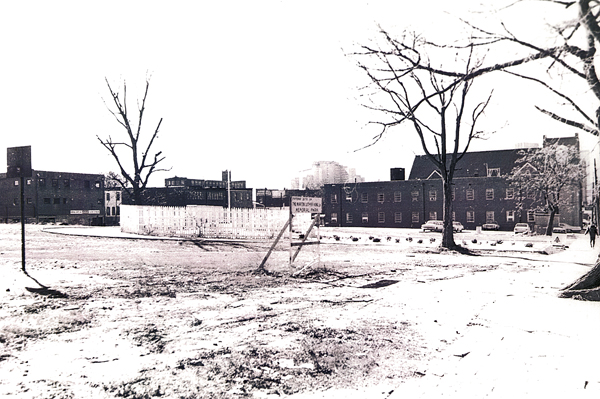
Figure 22. The future site of the King Center as it appeared around 1971.The sign reads "Future Site of King Memorial Park." Ebenezer and the Christian Education Building are at right. |
Located near where the present crypt is located, the new grave site was ready when the second annual commemoration of Dr. King's birthday was held at Ebenezer on Thursday, 15 January 1970. Nearly a thousand people crammed their way into the church for the service, which included remarks by Dr. Vincent Harding, acting director of the Martin Luther King Memorial Center, and Dr. Benjamin Mays, president emeritus at Morehouse and recently elected president of the Atlanta Board of Education. The church service was followed by a brief, graveside ceremony. In reporting the event, the Atlanta Constitution and the Atlanta Daily World both reported that the church, the crypt, and Dr. King's birthplace "are to all be parts of the Martin Luther King, Jr., Memorial Center." [47]
On Saturday, January 17, another component of the Memorial Center was opened at 87 Chestnut St. SW near the Atlanta University campus. Called the Institute of the Black World, it was part of a new wave of programs and projects across the country that aimed to reinforce pride in African-American culture. In addition to an open house at the Institute's headquarters, the program included "A Celebration of Blackness" which aimed "to recreate the experiences of black people from Africa to 1970 by way of the spoken word, song, dance, and musical instruments." [48]
By that time, plans were well underway for major alterations to Ebenezer. The architectural firm of Muldawer and Patterson was engaged for the work and they, in turn, associated themselves with J. W. Robinson, who had remodeled the King's house on Sunset Avenue in 1966. Muldawer and his wife, Carol, were active in the Civil Rights Movement and had become close friends with Andrew Young. As a result of that relationship, Muldawer had designed the Martin Luther King Jr. Village, a mixed-use development on Logan Street in southeast Atlanta for which ground was broken as part of the 1969 commemoration of Dr. King's birthday. [49]
In addition to his friendship with Young, Paul Muldawer had also established his reputation in Georgia's historic preservation movement, then in its formative years, when he developed the first set of design guidelines for new construction in Savannah's historic district in 1968. Thirty years later, those guidelines were expanded and revised but the fundamental philosophy of compatible design criteria that he developed in 1968 remained intact. Using those criteria, Muldawer designed major additions to Ebenezer that were intended to "echo" but not compete with or overwhelm the historic building. [50]
By June, the architects had completed plans that included several components, the most dramatic of which was the addition of a circular, memorial chapel in the parking lot at the rear of the church. Plans also called for construction of a new, two-story addition in front of the Christian Education Building and a connecting "hyphen" to the old church. In the church itself, plans called for partitioning and remodeling of the basement, presumably to provide meeting and office space for the Memorial Center; complete reconstruction of the stairwells and vestibule; enlargement of the baptismal pool; and a variety of other less-significant alterations and improvements to it and the Christian Education Building. [51]
|
Figure 23. Two sheets from the plans for the 1970 renovations and additions to the church showing the circular chapel proposed but never built at the rear of the church. (National Park Service) |
The plans were too ambitious, however; and, by the summer of 1970, it was clear that fund raising was falling far short of expectations. While Morehouse College had received significant donations in King's memory, the Auburn Avenue component of the King Memorial Center faced greater challenges in attracting support. Part of the reason for this may have been the condition of the surrounding neighborhood where, even before King's death, "urban renewal" had cleared whole blocks, including most of the block of Auburn Avenue between Jackson and Boulevard. By 1970, disinvestment in the Old Fourth Ward, which had begun long before King's death, and "white flight" from the city, which had begun in earnest in the 1960s, had turned what was left of his neighborhood into a crime-ridden slum. Homes, stores, and even churches were burglarized, often at gunpoint, and there were frequent assaults on pedestrians throughout the downtown area. On July 12, none other than the assistant pastor at Wheat Street Baptist was gunned down outside the rental office at Wheat Street Gardens at five o'clock in the afternoon. [52] It would be a long, uphill battle for those who had some vision for a historic district and a revitalization of the Old Fourth Ward.
So severe was the financial crisis at the Memorial Center that, in August, Mrs. King was forced to drastically reduce the staff at the King Library "due to a tenuous financial situation." The Daily World reported that the cutback in personnel "was made so that other projects, including the institute for non-violent social change and a memorial park surrounding her husband's crypt, could be gotten off the ground." A few days later, the Constitution reported more fully on the staff changes at the King Library Project and at the Institute for the Black World and noted that "the second component of the memorial center, still in the planning stages, will be located on Auburn Avenue, centered around Dr. King's birthplace and Ebenezer Baptist Church, where he served with his father as copastor." Mrs. King said, "We know that we need something like $10 to $20 million over a period of years to build the total complex." And, she added, "we may have to cut that back."[53]
By then, the final plans for Ebenezer had been approved by the city, but large components of the project had been deleted, including the new chapel and the remodeling of the basement. "No money," architect Robinson said simply, but noting that the church was also reluctant to give up what little off-street parking it had for construction of the chapel.
Still, the church had major issues that it needed to address, if it was going to fulfill even a part of its role in the memorial park, where King's grave was already a point of pilgrimage. As Robinson remembered, "Ebenezer had a number of problems. First thing, they started holding all the activity for Dr. King there and they realized that the only connection [between the old church and the Education Building] was the skywalk." In addition, "a whole lot of visitors was coming in every Sunday because they wanted to see the church that he had preached at" and there were tremendous problems with "the very narrow stairs" that formed the church's main entrance. [54]
In addition, Daddy King complained that during baptisms the congregation could not see the ceremony and the choir disliked the awkward access to the choir loft that required a temporary floor over the baptismal pool in order for them to pass back and forth to the doors at the rear of the loft. These problems had been addressed in the original design in a small connecting structure between the old church and the circular chapel. So, in order to address these problems, the decision was made to go ahead with the addition to the front of the Education Building, the remodeling of the stairwells and vestibule, and the expansion of the baptismal pool and halls at the rear of the church. A building permit was issued on August 18 and, a short time later, Robert Norwood Construction Co. began work on the project, which was valued at $68,000. [55]
The King Center continued its retrenchment for the next two years as Auburn Avenue became the primary focus for the King Memorial. On September 1, the King Memorial Center and the Institute for the Black World formally dissolved their ties after "it became clear to both the Center and the Institute that their interests and potential would be maximized by the Institute's becoming a fully autonomous and independent operation." [56]
In the face of practical realities, the King Center's vision for the memorial continued to evolve as it regrouped and reorganized. On 15 March 1972, the Martin Luther King Jr. Memorial Center was reincorporated as the Martin Luther King Jr. Center for Social Change, and Mrs. King turned the Center's full attention to the birth home. Architect J. W. Robinson was among those that began planning restoration of the birth home in 1972 and, the following year, work began there and in development of a master plan for the King Center. In November, Ebenezer conveyed title to the three-acre tract that it had acquired to the east of the church to the King Center and, although a dispute with the architects stalled the project, over four million dollars had been raised for the Center by April1974. [57] That same year, the long-sought historic district designation came to fruition with formal listing of the Martin Luther King Jr. Historic District in the National Register of Historic Places.
Although Ebenezer remained a strong and vibrant congregation, the last years of Reverend King's tenure were marked by tragedy. Barely a year after his eldest son's assassination in Memphis, Reverend King's younger son, A. D., died in an accidental drowning, depriving Daddy King not only of his other son but his right arm at Ebenezer as well. Then, on the last Sunday morning in June 1974, in the sanctuary at Ebenezer, Mrs. King Sr. was at the organ playing "The Lord's Prayer" when a deranged assassin opened fire, killing her and and Deacon Edward Boykin. Having lost both his sons, Reverend King Sr. found the loss of his wife, especially in such a way, almost too much to bear and, not wanting "the church to decline under my leadership," he tendered his resignation to the Board of Deacons that fall. In early January 1975, Reverend King baptized Ebenezer’s new minister, Rev. Joseph Lawrence Roberts Jr. and, in August, formally retired as pastor at Ebenezer Baptist Church. [58]
|
Figure 24. Ebenezer Baptist Church in 2010. (author's photograph) |
|
Figure 25. Looking east from the front entrance of Ebenezer in 1999. (author's photograph) |
|
Figure 26. Ebenezer's "Horizon" church, across the street from the historic "Heritage" church, was completed in 1996. (author's photograph) |
The Recent Past
In May 1977, the Martin Luther King Jr. Historic District was designated a National Historic Landmark, a category reserved for the nation's most significant historic properties. Included in the designation were both sides of Auburn Avenue between Boulevard and Howell Street as well as Ebenezer Baptist Church. A few months later, construction of the first phase of the King Center, which was designed by the New York architects Bond Ryder & Associates, was completed, including the permanent tomb, reflecting pool, colonnade, and "Chapel of All Faiths" at the King Center. Finally in October 1979, ground was broken for "Freedom Hall," which had been a feature of the Center's plans from the very beginning. Completed in 1981, it marked completion of the King Center complex.
In 1980, Congress created the Martin Luther King Jr. National Historic Site, a unit of the National Park Service system. Included in the new park were approximately thirty-five acres in the Old Fourth Ward. A visitor center, museum, and park administrative headquarters were built on the vacant block across Auburn Avenue from the King Center.
In November 1984, Daddy King died and was laid to rest at South View Cemetery. Reverend Roberts continued the "social action heritage" that had been created at Ebenezer by Dr. Williams and the Kings over the preceding decades. Under his tenure, the growing congregation recognized the historical significance of Ebenezer Baptist Church and began planning for their new "Horizon" sanctuary, which opened across the street from the original church, the "Heritage" sanctuary, in 1999.
In April of 1996, the United States through the Department of the Interior and the National Park Service (NPS) secured a 50-year lease on the original church building, with an option to renew the lease for an additional 49 years. The sanctuary of old Ebenezer Baptist Church continued to be a focus for King Day celebrations and other special occasions, and remained open as a multi-million-dollar, multi-year campaign began to rehabilitate the building, including restoration of the sanctuary to its appearance in 1968.
![]()
Notes
1. The church cornerstone provides the organizational date and Parker’s name.
2. Rev. G. S. Ellington, “A Short Sketch of the Life and Work of Rev. A. D. Williams, D. D.,” included in “Programme of the Thirtieth Anniversary of the Pastorate of Rev. A. D. Williams of Ebenezer Baptist Church, Beginning Monday Night, March 16, 1924.” The only notice of Ebenezer’s existence prior to the 1900 Atlanta City Directory is in the 1890 Directory, where Rev. John Parker, who resided at what was then 67 Howell Street, gave his occupation as “pastor, Ebenezer Bapt Ch.” The church itself had no listing.
3. Ellington and “Rev. A. D. Williams,” Atlanta Independent, 2 April 1904, establishes location on Airline St. and that “there was no building at all.” The “Souvenir Program . . . 1947” states that Parker died in 1894 and that the congregation was behind in payments on their building.
4. Accounts vary as to membership when Williams became pastor. “Rev. A. D. Williams, Atlanta Independent, 2 April 1904, and “Ebenezer Baptist Church’s Great Rally for New Church. . . ,” Atlanta Independent, 27 June 1914 set membership at 17; “Ebenezer Baptist Church,” Atlanta Independent, 12 July 1913, gives 18 members and mentions the “small shack” in which they were then meeting. A. B. Caldwell, ed., “Rev. A. D. Williams,” History of the American Negro and his Institutions, Georgia Edition. (Atlanta, 1917), states that there were only seven members. Later accounts, including Ellington, set the number of members in 1894 at 13. Caldwell also states that the congregation had “no church building at all.”
5. Atlanta Independent, 2 April 1904, suggests that they moved to McGruder Street around 1897 and Ellington states that the congregation built a church on McGruder Street, “what is now known as Mt. Pleasant Church.” Fulton County Superior Court, Record of Deeds and Mortgages, Book 148, pp. 304-305, dated 26 May 1899, gives purchase price for 50' x 150' lot as $550. Book 145, p. 265, dated 20 June 1900, gives sale price of $600. Atlanta Independent, 27 June 1914, states that they “bought and sold a church on McGruder Street, worth about $1,000.” The existing Mt. Pleasant Church on McGruder Street appears to have been constructed after 1914, although an older building could be hidden beneath a later remodeling. Atlanta Independent, 2 April 1904, puts Ebenezer's membership at 400 in that year; 12 July 1913 puts membership at 120 when they moved to Gilmer and Bell. Also see Fulton County, Deed Book 152, p. 76.
6. Ellington; Atlanta Independent, 2 April 1904; Fulton County, Deed Book 207, 119.
7. Fulton County, Deed Book 350, pp. 471, 587.
8. Michael Leroy Porter, “Black Atlanta: An Interdisciplinary Study of blacks on the East Side of Atlanta, 1890-1930” (Ph.D. dissertation, Emory University, 1974), 47; Fulton County Deed Book 350, p. 587; Book 464, pp. 269-272.
9. Fulton County Deed Book 350, p. 587; also see 1911 Sanborn Fire Insurance Maps.
10. “Ebenezer Baptist Church,” Atlanta Independent 12 July 1913.
11. Fulton County Deed Book 396, p. 117; Atlanta Independent, 17 Jan 1914, in an announcement of a “mass meeting” for proposed YMCA to be held at Ebenezer, “now on Edgewood avenue near Jackson street.” Modern histories say the building was located at 444 Edgewood, where a 1-story concrete store is shown in the 1911 Sanborn Fire Insurance Maps of Atlanta. The building was torn down by the 1920s for a commercial building.
12. Atlanta Independent, 14 March 1914; interviews with Jethro English Jr. and Christine King Farris. The Lodge that laid the stone has not been identified but was not the Prince Hall Lodge, according to the Lodge’s current Grand Master.
13. Atlanta Independent, 27 June 1914.
14. Ibid.
15. John Dittmer, Black Georgia in the Progressive Era, 1900-1920 (University of Illinois Press, 1980), 185-190; “Migrants Made ‘Good’ in Northern Industry,” Atlanta Independent, 27 March 1924; also Daddy King: An Autobiography (New York: William Morrow & Co., 1980), 14.
16. “A Worthy Cause,” Atlanta Independent, 28 February 1924.
17. Clifford M. Kuhn, Harlon E. Joye & E. Bernard West, Living Atlanta: An Oral History of the City, 1914-1948 (University of Georgia Press, 1990), 27.
18. “A Worthy Cause,” Atlanta Independent, 28 February 1924, implies that construction may have resumed in 1918; Fulton County, Deed Book 502, 575; City of Atlanta Building Permit #1502, on microfilm at Atlanta History Center.
19. Fulton County, Deed Book 456, p. 513.
20. Ellington; “A Worthy Cause,” Atlanta Independent, 28 February 1924.
21. Daddy King, 89.
22. Daddy King, 91-92.
23. Daddy King, 93.
24. Daddy King, 89.
25. Carson, 80.
26. “Souvenir Program, Sixtieth Anniversary of the Church and Fifteenth Anniversary of the Pastor, March 10-16, 1947."
27. Interviews with Mr. and Mrs. Jethro English and Miss Lillian Watkins, who thought that the urns may actually have been solicited by Mrs. Crawford, who was a caterer, from one of her employers. The 1947 Anniversary Program includes a photograph and information about Mrs. Crawford.
28. “Ebenezer Baptist Church Has New Pipe Organ,” Atlanta Daily World, 28 October 1940. Interview with David Stills, organist at the church 1950-1973, believed that the John Brown organ had been used in the old Gilmer Street church.
29. “Master Organ Is Dedicated At Ebenezer,” Atlanta Daily World, 2 November 1940. There is no mention in the several newspaper articles of Dr. Benjamin Mays’ dedication of the organ at that time as some have believed.
30. Daddy King, 99-101; “Souvenir Program...1947.”
31. Clayborn Carson, ed., The Papers of Martin Luther King Jr. (University of California Press, 1992), 86.
32. Ibid.
33. Carson, 88-90.
34. Carson, Vol. 2, 39-40; Fulton County Deed Book 2233, p. 357; Fulton County Deed Book 2662, p. 577.
35. Herman “Skip” Mason Jr., Going Against the Wind: A Pictorial History of African-Americans in Atlanta (Atlanta: Longstreet Press, 1992., 158); Fulton County, Deed Book 2964, p. 336; Plat Book 53, p. 14; “Ebenezer Dedicates Education Building,” Atlanta Daily World, 29 May 1956; City of Atlanta Building Permit #9461, microfilm, Atlanta Historical Society. Atlanta Daily World articles on 26 and 29 May 1956 credit Miller with the design, as does David Stills, organist at the church between 1950 and 1973.
36. Interview with David Stills. “Ebenezer Dedicates Education Building,” Atlanta Daily World, 29 May 1956.
37. Interview with J. V. Llorens, Jr., whose father began the company in 1921. Unfortunately, the company, which is still in business in Decatur, discarded all of the company’s old business records about 1995.
38. Coretta Scott King, Life With Martin, 167-168.
39. Daddy King, 304, 314-315; “King Returns To His Church,” Atlanta Constitution, 9 April 1968.
40. “Ebenezer Church Is Not Just a ‘Shrine’,” Atlanta Constitution, 14 January 1978.
41. City of Atlanta Building Permit # 5195, microfilm, Atlanta History Center.
42. Atlanta Constitution, 23 August 1968. Also see "Auburn-Boulevard Proposal, Martin Luther King Memorial," May 1968 in National Park Service, SERO-CRD files.
43. Ralph David Abernathy, And the Walls Came Tumbling Down (Chicago Review Press, 2010), 456; Daddy King, 204.
44.“Dr. King Baptizes Successor As Ebenezer Church Pastor,” Atlanta Constitution, 6 January 1975. “Pastor at Ebenezer To Pursue Heritage,” Atlanta Constitution, 11 October 1975.
45. Fulton County Deed Book 20941, pp. 60-66.
46. "Dr. King's Body Moved, A Memorial Is Planned," New York Times; "King Body Taken to New Site," Atlanta Constitution, "Dr. M.L. King Jr.'s Body Brought Home to Auburn Ave.," Atlanta Daily World, 14 Jan 1970.
47."1,000 Honor King at Church Service," Atlanta Constitution, 16 January 1970. "Martin Luther King Day," Atlanta Daily World, 18 January 1970.
48. "Official Opening of Martin Luther King Memorial Center," Atlanta Daily World, 18 January 1970.
49. Interview with Paul Muldawer; also "Spare King's Slayer, Rev. Abernathy Asks," Atlanta Constitution, 16 January 1969.
50. Interview with Paul Muldawer; "Spare King's Slayer, Rev. Abernathy Asks," Atlanta Constitution, 16 January 1969.
51. A complete set of these plans can be found on microfiche at the City of Atlanta's Bureau of Buildings but neither Muldawer nor Robinson have any original copies of the plans or other documents relating to the 1970 alterations.
52. Atlanta Daily World, 13 July 1970.
53. "Mrs. King Blames Financial Situation in Firings of 12," Atlanta Daily World, 6 August 1970; "Prospects of King Center Shrunken by Tight Budget," Atlanta Journal and Constitution, 16 August 1970.
54. Interview with J. W. Robinson.
55. Interview with J. W. Robinson. Paul Muldawer also remembers that the baptismal was altered to improve sight lines. City of Atlanta Building Permit, on microfilm at Atlanta History Center.
56. "King Center and Black Institute Dissolve All Ties," Atlanta Daily World, 8 September 1970.
57. Fulton County Deed Book 6022, pp. 312, 319.
58. Daddy King, 204; "Dr. King Baptizes Successor as Ebenezer Church
Pastor," Atlanta Constitution, 6 January 1975; "Pastor at Ebenezer to Pursue Heritage," Atlanta Constitution, 11 October
1975.
![]()
References
Abernathy, Ralph David. And the Walls Came Tumbling Down: An Autobiography. Chicago Review Press, 2010).
Caldwell, A. B., ed. History of the American Negro and his Institutions, Georgia Edition. Atlanta, 1917.
Carson, Clayborn, ed. The Papers of Martin Luther King, Jr. University of California Press, 1992.
Ebenezer Baptist Church. Ebenezer: A Centennial Time Capsule, 1886-1986. Ebenezer Centennial Publishing Committee, 1991.
King, Coretta Scott. My Life With Martin Luther King, Jr. New York: Holt & Co., 1969.
King, Rev. Martin Luther, Sr. Daddy King: An Autobiography. New York: William Morrow & Co., 1980.
Kuhn, Clifford M., Harlon E. Joye & E. Bernard West. Living Atlanta: An Oral History of the City, 1914-1948. University of Georgia Press, 1990.
Mason, Herman “Skip”, Jr. Going Against the Wind: A Pictorial History of African-Americans in Atlanta. Atlanta: Longstreet Press, 1992.
Porter, Michael Leroy. “Black Atlanta: An Interdisciplinary Study of Blacks on the East Side of Atlanta, 1890-1930.” Ph.D. dissertation, Emory Univ., 1974.
White, Dana F. “The Black Sides of Atlanta: A Geography of Expansion and Containment, 1870-1970.” The Atlanta Historical Journal 26 (Summer/Fall, 1982), pp. 199-225.
![]()
